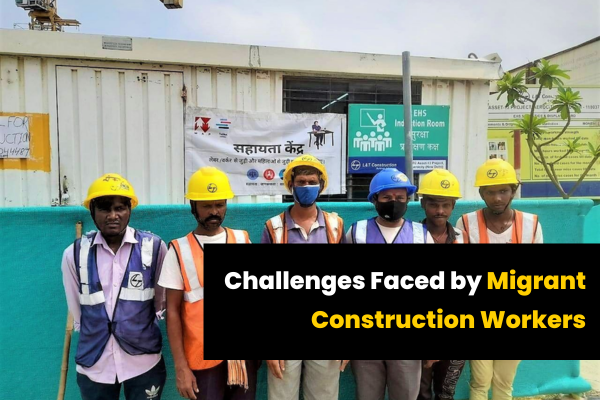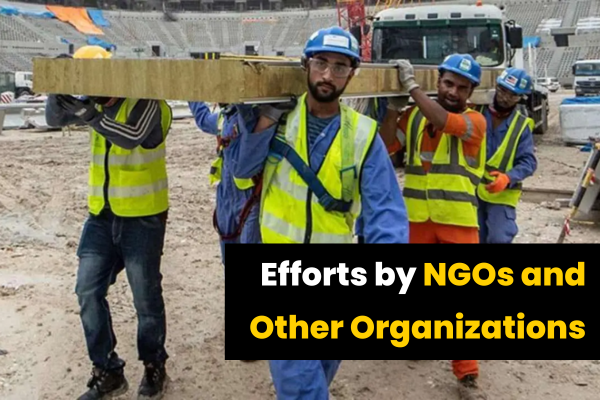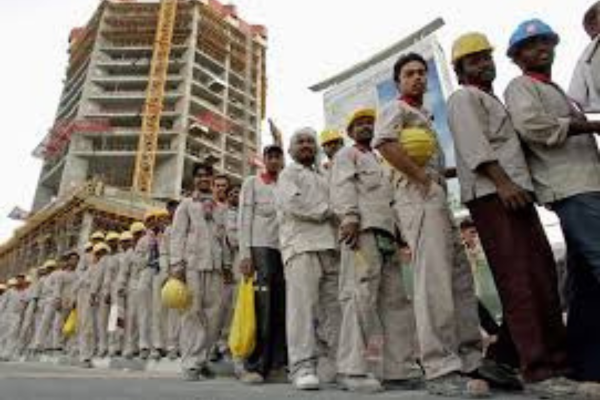Physical Address
Introduction

India’s migrant construction workers form a significant yet often overlooked segment of the country’s workforce. These individuals leave their homes in search of better economic opportunities, contributing to the growth of urban infrastructure and development projects across the nation. However, their journey is fraught with numerous challenges, ranging from poor living conditions to exploitation by employers. In this article, we delve deeper into the lives of India’s migrant construction workers, exploring their struggles, the impact of the COVID-19 pandemic, government policies, and potential solutions to improve their conditions.
Understanding India’s Migrant Construction Workers
Who are India’s migrant construction workers?
India’s migrant construction workers are individuals who leave their hometowns or villages to work in construction projects in urban areas, often residing in temporary settlements near construction sites. They typically come from rural areas and belong to lower socio-economic backgrounds.
Why do they migrate?
They migrate primarily in search of better employment opportunities and higher wages, as rural areas often lack sufficient job prospects. Economic factors, such as poverty, unemployment, and lack of livelihood options, push them to seek work in urban construction hubs, where demand for labor is high due to rapid urbanization and infrastructure development. Additionally, social factors like caste discrimination and landlessness contribute to their migration.
Challenges Faced by Migrant Construction Workers

Poor living conditions
Migrant construction workers often live in makeshift accommodations near construction sites, lacking basic amenities such as clean water, sanitation facilities, and proper ventilation. These substandard living conditions pose serious health risks and contribute to the vulnerability of workers and their families.
Health hazards
Construction sites expose workers to various occupational hazards, including accidents, injuries, and exposure to harmful substances such as dust and chemicals. Lack of access to healthcare exacerbates these risks, making migrant workers more susceptible to illnesses and injuries.
Exploitation and low wages
Migrant construction workers are frequently exploited by contractors and employers who pay below minimum wages and subject them to long hours of labor without adequate rest or breaks. Moreover, the transient nature of their employment makes it difficult for workers to assert their rights or demand better working conditions.
Government Initiatives and Policies
Existing government schemes aim to address the challenges faced by migrant construction workers, including housing programs, healthcare facilities, and skill development initiatives. However, the implementation of these policies often faces logistical challenges and bureaucratic hurdles, limiting their effectiveness.
The Indian government has implemented several initiatives and policies to address the challenges faced by migrant construction workers:
- Inter-State Migrant Workmen (Regulation of Employment and Conditions of Service) Act, 1979: This legislation aims to regulate the employment and conditions of service of inter-state migrant workers, ensuring they receive fair wages, proper accommodation, and other benefits.
- Building and Other Construction Workers (Regulation of Employment and Conditions of Service) Act, 1996: This act mandates the registration of construction workers and the provision of welfare measures such as health, safety, and social security benefits.
- Mahatma Gandhi National Rural Employment Guarantee Act (MGNREGA): MGNREGA provides a legal guarantee for 100 days of wage employment in a financial year to rural households, thus reducing distress migration by creating job opportunities in rural areas.
- Pradhan Mantri Awas Yojana (PMAY): PMAY aims to provide affordable housing to all urban and rural poor, including construction workers, through various schemes such as Credit Linked Subsidy Scheme (CLSS) and Affordable Housing in Partnership (AHP).
- Skill Development Initiatives: The government has launched skill development programs like Pradhan Mantri Kaushal Vikas Yojana (PMKVY) to impart relevant skills to construction workers, enhancing their employability and income levels.
- Social Security Schemes: Various social security schemes such as the Atal Pension Yojana (APY) and Pradhan Mantri Jeevan Jyoti Bima Yojana (PMJJBY) provide insurance and pension benefits to construction workers and their families.
These initiatives aim to safeguard the rights, improve the living standards, and enhance the socio-economic conditions of migrant construction workers in India. However, effective implementation and monitoring remain crucial for ensuring their successful outcomes.
Impact of COVID-19 Pandemic

The COVID-19 pandemic has exacerbated the vulnerabilities of India’s migrant construction workers, with many facing job losses, wage cuts, and difficulties in accessing essential services during lockdowns. The sudden disruption of construction activities has left thousands stranded without income or support.
The COVID-19 pandemic has significantly impacted migrant construction workers in India:
- Loss of Livelihood: Many construction projects were halted or delayed due to lockdowns and restrictions, leading to a loss of income for migrant workers who heavily rely on daily wages. This loss of livelihood exacerbated their financial insecurity.
- Forced Migration: With the sudden loss of income and uncertainty, many migrant workers faced the dilemma of either staying in cities without work or returning to their villages. The lack of transportation facilities during lockdowns forced some to undertake arduous journeys on foot, facing hardship and health risks.
- Health Risks: Migrant construction workers often live in crowded and unhygienic accommodations near construction sites, making them vulnerable to COVID-19 transmission. Lack of access to healthcare facilities and information further increased their risk.
- Social Impact: The pandemic highlighted the socio-economic vulnerabilities of migrant workers, leading to increased awareness about their plight. It also exposed the gaps in social security measures and highlighted the need for better welfare policies for this marginalized group.
- Psychological Impact: The uncertainty and stress caused by the pandemic, coupled with financial hardships and separation from families, took a toll on the mental health of migrant workers, leading to anxiety, depression, and other psychological issues.
- Policy Response: The pandemic prompted governments and NGOs to take steps to mitigate the impact on migrant workers, including providing relief packages, food distribution, transportation assistance, and setting up shelters. However, challenges in implementation and reaching all affected workers remained.
Overall, the COVID-19 pandemic exacerbated the vulnerabilities of migrant construction workers in India, highlighting the need for comprehensive social protection measures, improved living conditions, and greater attention to their rights and well-being.
Efforts by NGOs and Other Organizations

Non-governmental organizations (NGOs) and civil society groups play a crucial role in providing support services to migrant construction workers, including shelter, healthcare, education, and legal aid. These organizations also advocate for the rights and welfare of workers, raising awareness about their plight and lobbying for policy reforms.
Several NGOs and other organizations have undertaken efforts to support migrant construction workers during the COVID-19 pandemic in India:
- Providing Relief Aid: NGOs like Oxfam India, Goonj, and ActionAid have distributed relief kits containing essential food items, hygiene kits, and other necessities to migrant workers stranded in cities or returning to their villages.
- Shelter and Accommodation: Organizations like Pratham, SEWA Bharat, and Habitat for Humanity have set up temporary shelters and provided accommodation to migrant workers who were stranded or faced homelessness due to the pandemic-induced economic crisis.
- Healthcare Support: NGOs such as Doctors Without Borders (MSF), CARE India, and Smile Foundation have provided healthcare services, including medical consultations, COVID-19 testing, and awareness campaigns, targeting migrant workers in both urban and rural areas.
- Legal Aid and Advocacy: Organizations like Human Rights Law Network (HRLN) and Amnesty International India have provided legal aid to migrant workers facing issues such as wage theft, eviction, and denial of entitlements. They also engage in advocacy efforts to raise awareness about the rights and issues of migrant workers.
- Skill Development and Livelihood Support: NGOs such as Pratham, Yuva Parivartan, and Gram Tarang have focused on providing skill development training and livelihood support to migrant workers, helping them acquire new skills or access employment opportunities in different sectors.
- Psychosocial Support: Organizations like Snehi and Sangath have offered psychosocial support and counseling services to migrant workers experiencing mental health issues such as stress, anxiety, and trauma due to the pandemic and its aftermath.
These efforts by NGOs and other organizations have played a crucial role in providing immediate relief, addressing the needs, and advocating for the rights of migrant construction workers during the challenging times of the COVID-19 pandemic.
Case Studies
Several successful interventions have demonstrated the potential for improving the lives of migrant construction workers. From community-led initiatives to innovative technology solutions, these case studies highlight the importance of collaboration between government, NGOs, and the private sector in addressing the needs of vulnerable populations.
Certainly, here are two case studies that shed light on the experiences of Indian construction workers:
- Case Study 1: Ravi’s Journey Home During the Lockdown
- Ravi, a 35-year-old construction worker from Bihar, was employed at a construction site in Mumbai. When the nationwide lockdown was announced in March 2020 due to the COVID-19 pandemic, all construction activities came to a halt. With no income and limited savings, Ravi faced uncertainty and decided to return to his village in Bihar.
- Challenges:
- Ravi, like many other migrant construction workers, faced numerous challenges during his journey home.
- He had to walk long distances due to the lack of transportation, often without sufficient food and water.
- The journey took several days, and he encountered exhaustion, blisters, and health risks along the way.
- Intervention:
- NGOs such as Goonj and local community organizations provided relief aid to migrants like Ravi during their journey home.
- They distributed food packets, water, and hygiene kits at various checkpoints along highways to support the migrant workers.
- Outcome:
- Despite the hardships, Ravi eventually reached his village safely with the help of relief efforts by NGOs and community organizations.
- Case Study 2: Maya’s Struggle for Livelihood in Urban Construction
- Maya, a 28-year-old woman from Odisha, migrated to Bengaluru with her husband in search of employment opportunities in the construction sector. They lived in a makeshift settlement near the construction site where they worked.
- Challenges:
- Maya faced multiple challenges as a female construction worker in a male-dominated industry.
- She often encountered discrimination, harassment, and unequal pay compared to her male counterparts.
- Additionally, the lack of access to healthcare and childcare facilities added to her struggles.
- Intervention:
- NGOs like SEWA Bharat and local women’s organizations provided support to Maya and other female construction workers.
- They conducted awareness sessions on women’s rights, provided skill development training, and facilitated access to healthcare services and childcare support.
- Outcome:
- With the support of NGOs and women’s organizations, Maya gained confidence and skills to assert her rights in the workplace.
- She also received access to healthcare services and childcare support, which improved her overall well-being and enabled her to continue working in the construction sector with dignity.
These case studies highlight the diverse experiences and challenges faced by Indian construction workers, as well as the interventions by NGOs and community organizations to support their rights, livelihoods, and well-being.
Role of Technology
Technology plays a crucial role in transforming the construction industry by enhancing efficiency, safety, and sustainability. Advancements such as Building Information Modeling (BIM), drones, and 3D printing enable precise planning, cost optimization, and faster construction processes. Internet of Things (IoT) devices monitor construction sites in real-time, ensuring safety and timely interventions. Additionally, virtual reality (VR) and augmented reality (AR) facilitate immersive training experiences and visualize designs, improving collaboration and decision-making. Furthermore, innovative materials and green technologies promote sustainability, reducing environmental impact. Overall, technology integration revolutionizes construction practices, driving progress towards smarter, safer, and more sustainable built environments.
Future Prospects
The future of the construction industry holds promising prospects driven by technological innovation, sustainability, and resilience. Advancements such as robotics, artificial intelligence (AI), and automation will revolutionize construction processes, increasing efficiency and productivity. Sustainable practices, including green building materials and renewable energy integration, will become standard, addressing environmental concerns and regulatory requirements. Furthermore, digitalization and data analytics will enable smarter decision-making, enhancing project management and risk mitigation. With a growing emphasis on resilience against climate change and urbanization challenges, the construction industry is poised for transformative growth, shaping resilient, sustainable, and technologically advanced built environments for the future.
FAQs
- What are the main reasons for migration among India’s construction workers?
- India’s construction workers often migrate in search of better economic opportunities, including higher wages and steady employment.
- How does the COVID-19 pandemic affect migrant construction workers?
- The pandemic has led to job losses, wage cuts, and increased vulnerability among migrant construction workers, highlighting the need for social support and safety nets.
- What role do NGOs play in supporting migrant construction workers?
- NGOs provide essential services such as shelter, healthcare, education, and legal aid to migrant construction workers, advocating for their rights and welfare.
- How can technology improve working conditions for migrant construction workers?
- Technology solutions such as mobile apps and wearable devices can enhance worker safety, health monitoring, and access to information and services on construction sites.
- What are some long-term strategies to address the challenges faced by migrant construction workers?
- Long-term solutions include investments in affordable housing, healthcare, education, and social protection programs, as well as efforts to address systemic issues such as poverty and inequality.
Conclusion
In conclusion, India’s migrant construction workers play a crucial role in the country’s development but face numerous challenges that undermine their well-being and livelihoods. By addressing the root causes of migration, improving working conditions, and empowering workers with access to essential services and social protections, we can create a more inclusive and equitable society for all.

